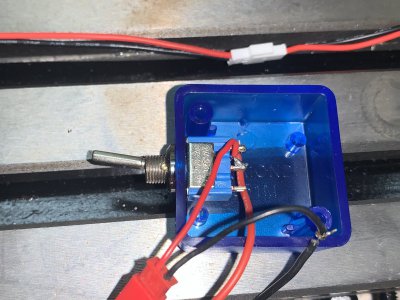Between days doing the larger work in the shop I found a couple of things on the table/base that I thought needed addressed.
First up was the table lock screws. These were nice indexing handle type units, but they were hideously long and looked like they could get in the way or broken so I shortened them on the lathe.
As delivered:
View attachment 452659
And drastically shortened.
View attachment 452660
Much better. I did this to both the X and Y locks and decided the X needed a second lock on the opposite side so the table will not twist when the single lock was tightened, so I ordered one from LMS to be installed. The Y lock was centered in the gib so I figured that one was fine.
Back in the shop I finished the cosmetic slot going across the top and down the edge where the saw cut was to go, and began drilling the holes to mount it to the mill table. I had to leave the saw cut for last to ensure everything stayed square and rigid for the rest of the steps to be performed.
View attachment 452661
After the mounting holes were finished I cut the front corner on a 45* angle to give it a nicer and more factory look. I hesitated on this as I wanted as much rigidity and especially mass in the machine as possible, but in the end this piece came out to 20lbs of solid steel VS 3lbs of cast aluminum on the factory part its replacing.
Should be more than good enough.
View attachment 452662
In the above pic it was setup to be milled flat, then was later ground to match the rest of the surfaces.
At this point I brought it home and mated it up with the base. Any miscalculations would be discovered at this stage before going any further and possibly needing to scrap the whole works, but everything fit perfectly. That was a nice surprise as I only had .004 clearance on the bolt holes.
View attachment 452667
Next up was the threaded and bored clamping bolt holes. I drilled and tapped for M8-1 bolts using fine threads to increase the clamping forces.
View attachment 452668
I counter bored these holes so the head of the cap screws would stand slightly proud of the surface so they would be easy to feel from the front of the machine to loosen/tighten with a wrench until I can make some factory style locking levers similar to what's on the vertical clamping lock for the head.
Here I have it in position to tap the holes. I made the counter bores large enough to accept the tap handle jaws as to allow the maximum thread depth for increased longevity of the threads.
View attachment 452669
Then the final step was the saw cut.
View attachment 452670
After the saw cut was done I sandblasted the whole thing to
hide my sins give it a good surface for paint to adhere to.
And with that finished I put it together and everything looked fine and worked well, then the doorbell rang.
My vise was here just at the perfect moment.
All together and (Mostly) ready to go.
View attachment 452671
Cute, isn't it?
View attachment 452672
I ordered a 3" vise as I wasn't sure how much it would stick off the back of the table or the quality of the brand, but there's more than enough room and the vise is nice enough, so Ill probably order the same vise in 4" as the 3" seems just a tad small. The 4" is also almost twice the weight so it will help with the mass equation.
Just need my clamping bolts and the ER-20 collet chuck and collets to show up and I can start to use it.

![IMG_3236[1].JPG IMG_3236[1].JPG](https://www.hobby-machinist.com/data/attachments/412/412044-0ac25f61cd48fc29f87785f987675bef.jpg?hash=CsJfYc1I_C)
![IMG_3240[1].JPG IMG_3240[1].JPG](https://www.hobby-machinist.com/data/attachments/412/412045-376087f21efa95ec79083e35320a124a.jpg?hash=N2CH8h76le)
![IMG_3238[1].JPG IMG_3238[1].JPG](https://www.hobby-machinist.com/data/attachments/412/412047-fcbdccbe66d9fe19d8d71456948184a0.jpg?hash=_L3MvmbZ_h)
![IMG_3239[1].JPG IMG_3239[1].JPG](https://www.hobby-machinist.com/data/attachments/412/412048-a05f8386d4f77819936b56d60ce4796c.jpg?hash=oF-DhtT3eB)
![IMG_3233[1].JPG IMG_3233[1].JPG](https://www.hobby-machinist.com/data/attachments/412/412055-3bc8e5388c3988e08d45916920001c0a.jpg?hash=O8jlOIw5iO)












![IMG_3366[1].JPG IMG_3366[1].JPG](https://www.hobby-machinist.com/data/attachments/414/414317-053ad89330cb927064e49dd4cd818363.jpg?hash=BTrYkzDLkn)
![IMG_3365[1].JPG IMG_3365[1].JPG](https://www.hobby-machinist.com/data/attachments/414/414316-c1d652e6bb55c8dafbb7b533377fcf00.jpg?hash=wdZS5rtVyN)
![IMG_3364[1].JPG IMG_3364[1].JPG](https://www.hobby-machinist.com/data/attachments/414/414318-1e682292c95baa686ec2371178d86533.jpg?hash=Hmgikslbqm)





![IMG_3421[1].JPG IMG_3421[1].JPG](https://www.hobby-machinist.com/data/attachments/416/416598-b6b66fca506de468a466c15075d39f91.jpg?hash=trZvylBt5G)
![IMG_3431[1].JPG IMG_3431[1].JPG](https://www.hobby-machinist.com/data/attachments/416/416599-f22fd8ac2fff61c68e86e05f53d4ee8d.jpg?hash=8i_YrC__Yc)
![IMG_3432[1].JPG IMG_3432[1].JPG](https://www.hobby-machinist.com/data/attachments/416/416600-a3742503378aff6ed18c58f7d268d73a.jpg?hash=o3QlAzeK_2)
